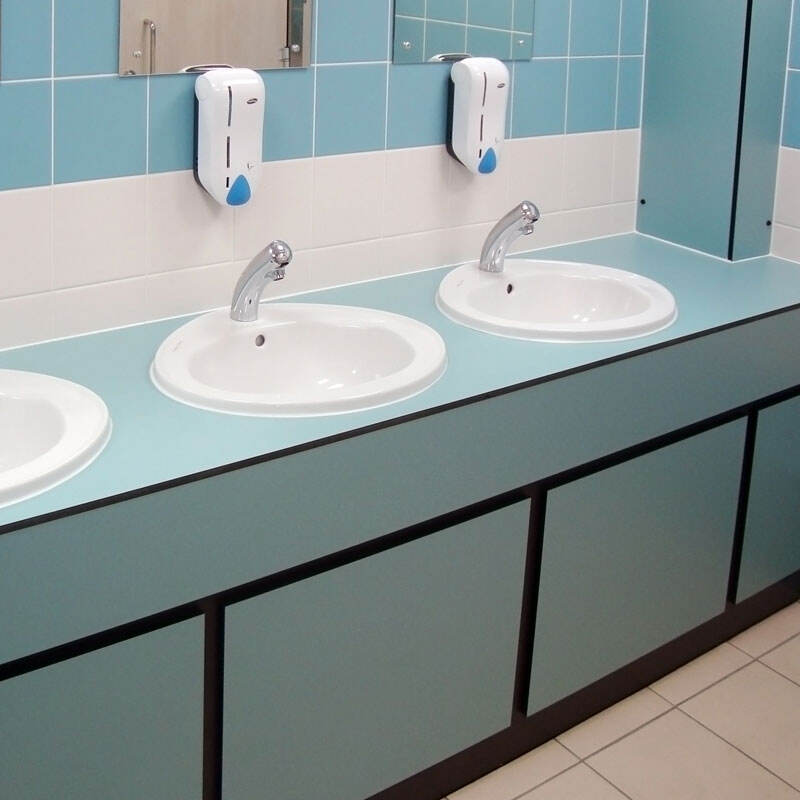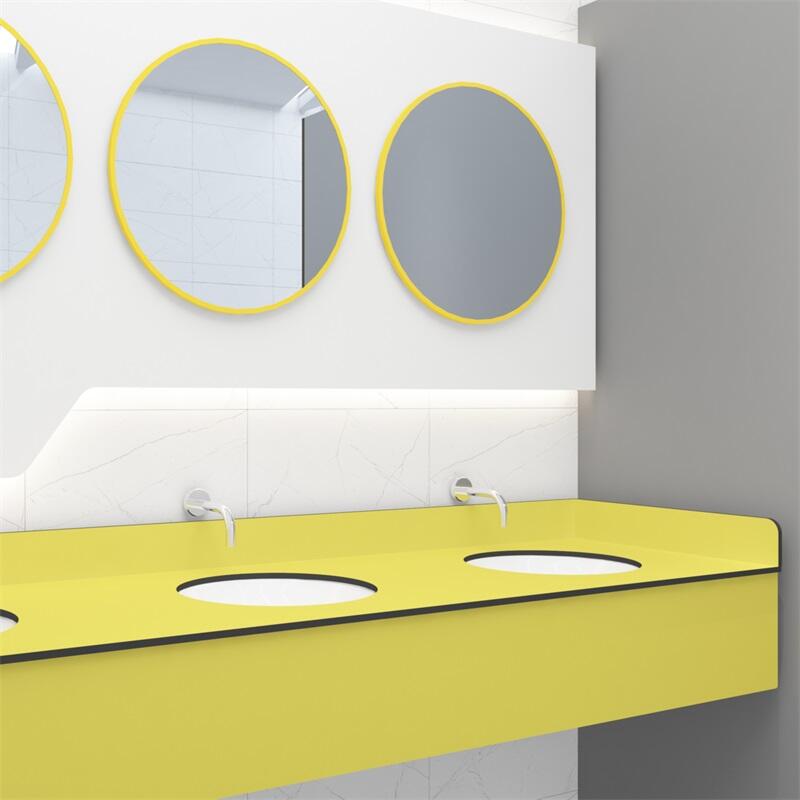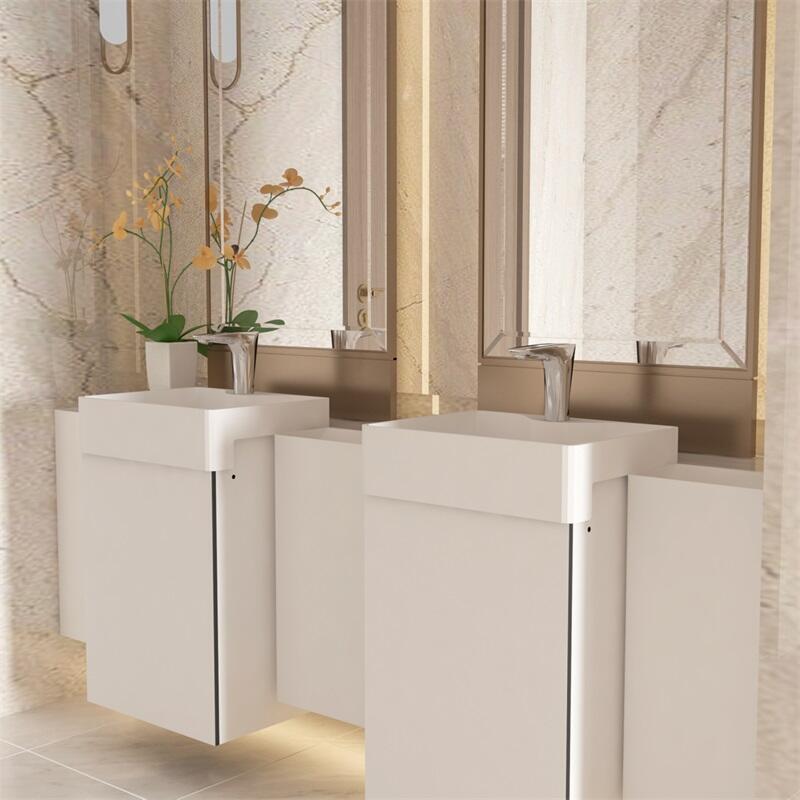Key Design Principles for Public Restroom Vanities
Balancing Aesthetics and Durability in High-Traffic Areas
Selecting materials that are both durable and visually appealing is crucial for public restrooms in high-traffic areas. Such spaces require vanities that can withstand wear and tear while offering a pleasant aesthetic experience. Choosing materials like stainless steel, solid surface, or high-density polyethylene can ensure longevity. These materials not only resist damage but also maintain a sleek appearance over time. To enhance the ambiance, consider integrating calming color schemes and luxurious finishes that don’t compromise durability.
Statistics show that materials in public restrooms can experience significant wear, with usage in some facilities reaching thousands of people daily. This underscores the need for robust materials that can handle frequent contact without deteriorating. Utilizing durable yet stylish bathroom wall panels can significantly enhance the space's ambiance while ensuring that the design endures over the years. By achieving a balance between aesthetics and durability, public restrooms can remain inviting and functional.
Space Optimization Strategies for Compact Layouts
Space optimization is pivotal in compact restroom layouts, where every inch matters. Implementing wall-mounted vanities can free up floor space, thus creating the illusion of a larger area. Such designs are not only space-efficient but can also include extra storage options, like built-in shelving or towel racks, making them both functional and visually appealing.
Multifunctional design elements, like integrating a sink with countertop space or having mirrored cabinets for storage, help maximize utility without sacrificing style. These innovations ensure that even smaller spaces are efficiently utilized. For instance, a restroom layout that incorporated space-saving vanities with strategically placed restroom stalls demonstrated increased efficiency and user satisfaction.
Case studies on successful public restroom designs show that using compact design principles increases both space utility and user comfort. Incorporating elements like sliding doors and strategically mounted fixtures can enhance the flow and functionality of the space, making even the smallest areas practical and inviting.
Material Selection for Long-Lasting Performance
Waterproof Compact Laminate Advantages
Waterproof compact laminates are a top choice for bathrooms due to their moisture resistance, durability, and low maintenance needs. Unlike traditional wood that can degrade quickly in damp conditions, compact laminates are designed to withstand humidity without warping or swelling. Studies show that these materials often outlast wood, providing a longer lifespan in high-moisture environments. Additionally, the smooth surface of waterproof laminates helps maintain hygienic conditions by preventing bacteria growth, ensuring a clean environment essential for public restrooms.
Vandal-Resistant Features for Public Environments
In public environments, selecting vandal-resistant materials like high-pressure laminate and stainless steel is crucial. These materials are specifically engineered to withstand aggressive use and damage, minimizing repair and replacement costs over time. According to recent reports, vandalism in public restrooms is a common issue, leading to significant financial implications. By incorporating resistant materials, facilities can reduce the frequency and cost of repairs due to vandalism, making them a cost-effective choice for public settings. Moreover, the durability of these materials ensures that restroom features remain intact and functional despite heavy usage.
Customizable Vanity Solutions for Modern Restrooms
Vanity Units to Match Toilet Design
Creating a cohesive restroom aesthetic involves synchronizing vanity designs with toilet styles. Integrating vanities and toilets with matching design elements such as colors, materials, and geometric shapes can significantly enhance the visual appeal of a restroom. For instance, using similar color palettes across both fixtures ensures a unified look, while consistent materials like ceramic or stainless steel maintain a harmonious theme. Such customizations not only embellish restroom environments but also amplify user experience by offering a personalized touch tailored to specific facility needs. Custom bathroom vanities, therefore, are vital in developing cohesive restroom designs that reflect the facility's overall aesthetic.
Waterproof HPL Bathroom Vanity Units
High-pressure laminate (HPL) is renowned for its exceptional water resistance and durability, making it ideal for bathroom vanity units. HPL materials withstand humidity and daily wear, perfect for both residential and commercial restrooms. Market trends indicate a rising popularity of HPL due to its sleek visual appeal and practical benefits, such as ease of maintenance and longevity. Users and design experts alike praise HPL vanities for public restrooms, appreciating their ability to maintain aesthetic beauty while offering resilience against constant moisture exposure. Consequently, HPL bathroom units are a preferred choice for modern, waterproof bathroom solutions.
Stylish Bathroom Vanity Storage Cabinet
Storage solutions in public restrooms play a critical role in maintaining cleanliness and organization. Stylish bathroom vanity storage cabinets offer the perfect blend of practicality and design to enhance restroom atmospheres. Incorporating elements like hidden compartments and sleek finishes, these cabinets ensure user convenience while maximizing utility. By carefully considering physical space and opting for integrated storage options, facilities can efficiently use available space without compromising on aesthetics. Effective restroom organization through stylish storage helps maintain an orderly environment, significantly improving user experience.
Installation and Maintenance Considerations
Modular Assembly for Quick Deployment
Modular restroom vanity units offer significant advantages for facilities interested in quick and flexible installations. These systems allow for efficient assembly and disassembly, thus reducing both time and labor costs. For instance, a recent installation in a corporate office demonstrated that modular units could be set up in just two days, minimizing disruption to daily operations. The modular design also facilitates easier repairs and upgrades. Should a panel become damaged, it can be swiftly replaced without requiring major reconstruction. This adaptability not only enhances operational efficiency but also allows for design alterations to be made with minimal downtime.
Cleaning Protocols for Hygienic Public Spaces
Maintaining cleanliness and hygiene in public restrooms is crucial, and choosing materials that allow for easy cleaning can greatly aid this process. Materials such as high-pressure laminate (HPL) are recommended for their resilience against stains and bacteria. For effective sanitation, non-abrasive cleaning products should be used to preserve material integrity while ensuring hygienic conditions. According to recent public hygiene standards, facilities are encouraged to follow structured cleaning schedules and protocols to maintain high cleanliness levels. Compliance with these standards not only ensures user safety but also enhances the facility's reputation by showing a commitment to health and hygiene.
Enhancing User Experience Through Smart Design
Integrating Mirrors and Lighting Effectively
Implementing strategically placed mirrors and effective lighting significantly enhances the user experience in restroom environments. By carefully positioning mirrors, designers can create the illusion of a more spacious room, which is especially beneficial in smaller bathroom settings. As Jameelah Davis and Ebonee Clark from Lauren Wesley Designs suggest, the illusion of space can be achieved through floating vanities and hidden pipes. Lighting, on the other hand, impacts functionality and safety. Proper lighting ensures visibility, reducing potential hazards, and enhances the aesthetic appeal of the restroom, contributing to overall user satisfaction. Research indicates that well-designed restroom environments, with adequate mirrors and lighting, contribute significantly to user satisfaction levels, reflecting positively on the facility.
Coordinating With Toilet Partitions and Wall Panels
Achieving a cohesive and harmonious restroom design involves coordinating vanity elements with toilet partitions and wall panels. Unified design not only enhances aesthetics but also contributes to a more comfortable and welcoming environment. Examples of successful coordination include matching colors and materials, creating a seamless flow between all components. Utilizing complementary bathroom wall panels with closely aligned toilet partitions helps in creating a unified look, benefiting user experience significantly. Industry standards provide guidance on achieving this coordination, ensuring that design choices align seamlessly with functional requirements. By integrating these elements thoughtfully, facilities can create restrooms that are both visually appealing and functionally superior.




